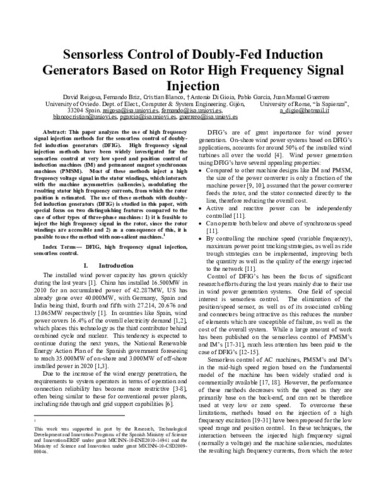Sensorless control of doubly-fed induction generators based on rotor high frequency signal injection
Fecha de publicación:
Editorial:
IEEE
Versión del editor:
Citación:
Descripción física:
Resumen:
This paper analyzes the use of high-frequency signal injection methods for the sensorless control of doubly fed induction generators (DFIGs). High-frequency signal injection methods have been widely investigated for the sensorless control at very low speed and position control of induction machines and permanent-magnet synchronous machines. Most of these methods inject a high-frequency voltage signal in the stator windings, which interacts with the machine asymmetries (saliencies), modulating the resulting stator high-frequency currents, from which the rotor position is estimated. The use of these methods with DFIGs is studied in this paper, with special focus on two distinguishing features compared with the case of other types of three-phase machines: 1) It is feasible to inject the high-frequency signal in the rotor since the rotor windings are accessible; and 2) as a consequence of this, it is possible to use the method with nonsalient machines
This paper analyzes the use of high-frequency signal injection methods for the sensorless control of doubly fed induction generators (DFIGs). High-frequency signal injection methods have been widely investigated for the sensorless control at very low speed and position control of induction machines and permanent-magnet synchronous machines. Most of these methods inject a high-frequency voltage signal in the stator windings, which interacts with the machine asymmetries (saliencies), modulating the resulting stator high-frequency currents, from which the rotor position is estimated. The use of these methods with DFIGs is studied in this paper, with special focus on two distinguishing features compared with the case of other types of three-phase machines: 1) It is feasible to inject the high-frequency signal in the rotor since the rotor windings are accessible; and 2) as a consequence of this, it is possible to use the method with nonsalient machines
ISSN:
Patrocinado por:
This work was supported in part by the Research, Technological Development and Innovation Programs of the Ministry of Science and Innovation under grant MICINN-10-CSD2009-00046 and of the Spanish Ministry of Science and Innovation-ERDF under grants MICINN-10-ENE2010-14941 and MICINN-10-IPT-370000-2010-15
Colecciones
Ficheros en el ítem




